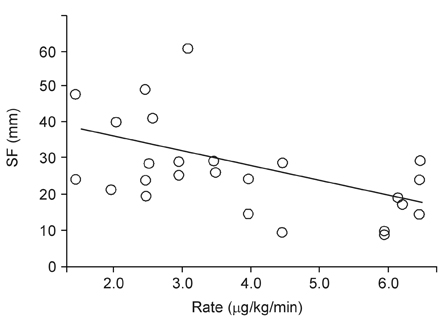Yonsei Med J.
2005 Oct;46(5):643-647. 10.3349/ymj.2005.46.5.643.
The Relationship of the Anthropometric Variables to the Infusion Rate of Rocuronium in the Elderly
- Affiliations
-
- 1Department of Anesthesiology and Pain Medicine, Anesthesia and Pain Research Institute, Yonsei University College of Medicine, Seoul, Korea. koobn@yumc.yonsei.ac.kr
- KMID: 2158143
- DOI: http://doi.org/10.3349/ymj.2005.46.5.643
Abstract
- We have determined the infusion rates of rocuronium in the elderly and young adult patients during sevoflurane and nitrous oxide anesthesia. The correlation of some anthropometric predictors with infusion rate of rocuronium was also investigated for both elderly and young adult. Participating patients were assigned to one of two groups: 1) young adult patients aged 20 to 50 years (n = 30) ; 2) elderly patients aged over 65 years (n = 30). The anthropometric variables such as height, weight, ratio of weight to body surface area, subscapularis and suprailiac skin folds, body surface area, body mass index and % ideal body weight were evaluated as predictors for infusion rate. The infusion rate in elderly patients was significantly less compared with that in young adult patients (p < 0.05). In elderly patients, no anthropometric predictor was related to the infusion rate of rocuronium. This suggests that the infusion rate of rocuronium for an elderly patient needs to be individualized by monitoring neuromuscular transmission to avoid excessive dose.
Keyword
MeSH Terms
Figure
Reference
-
1. Kopman AF. McLesky CH, editor. Effects of muscle relaxants and reversal agents. Geriatric anesthesiology. 1997. Baltimore: Williams & Wilkins;299–309.2. Matteo RS, Ornstein E, Schwart AE, Ostapkovich N, Stone JG. Pharmacokinetics and pharmacodynamics of rocuronium (Org 9426) in elderly surgical patients. Anesth Analg. 1993. 77:1193–1197.3. Bevan DR, Fiset P, Balendran P, Law-Min JC, Ratcliffe A, Donati F. Pharmacodynamic behaviour of rocuronium in the elderly. Can J Anaesth. 1993. 40:127–132.4. Sparr HJ, Khuenl-Brady KS, Erickson LI. Pharmacodynamics and pharmacokinetics of rocuronium following continuous infusion in patients during intravenous anaesthesia. Eur J Anaesthesiol Suppl. 1994. 9:63–65.5. Hunter JM. Rocuronium: The newest aminosteroid neuromuscular blocking drug. Br J Anaesth. 1996. 76:481–483.6. McCoy EP, Mirakhur RK, Maddineni VR, Wierda JM, Proost JH. Pharmacokinetics of rocuronium after bolus and continuous infusion during halothane anaesthesia. Br J Anaesth. 1996. 76:29–33.7. McCoy EP, Mirakhur RK, Maddineni VR, Loan PB, Connolly F. Administration of rocuronium (Org 9426) by continuous infusion and its reversability with anticholinesterases. Anaesthesia. 1994. 49:940–945.8. Woloszczuk-Gebicka B, Lapcznski T, Wierzejski W. The influence of halothane, isoflurane and sevoflurane on rocuronium infusion in children. Acta Anaesthesiol Scand. 2001. 45:73–77.9. Wierda JM, Kleef UW, Lambalk LM, Kloppenburg WD, Agoston S. The pharmacodynamics and pharmacokinetics of Org 9426, a new non-depolarizing neuromuscular blocking agent, in patients anaesthetized with nitrous oxide, halothane and fentanyl. Can J Anaesth. 1991. 38:430–435.10. Bock M, Klippel K, Nitsche B, Bach A, Martin E, Motsch J. Rocuronium potency and recovery characteristics during steady-state desflurane, sevoflurane, isoflurane or propofol anaesthesia. Br J Anaesth. 2000. 84:43–47.11. Du Bois D, Du Bois EF. A formula to estimate the approximate surface area if height and weight be known. Nutrition. 1989. 5:303–311.12. Matz R. Calculating body mass index. Ann Intern Med. 1993. 118:232.13. Pai MP, Paloucek FP. The origin of the "ideal" body weight equations. Ann Pharmacother. 2000. 34:1066–1069.14. Devine BJ. Gentamicin therapy. Drug Intell Clin Pharm. 1974. 8:650–655.15. Rupp SM, Castagnoli KP, Fisher DM, Miller RD. Pancuronium and vecuronium pharmacokinetics and pharmacodynamics in younger and elderly adults. Anesthesiology. 1987. 67:45–49.16. De Almeida MC, Latorre F, Gervais HW, Kleeman PP. The effects of age on onset and recovery from atracurium, rocuronium and vecuronium blockade. Anaesthesist. 1996. 45:903–906.17. Shanks CA. Pharmacokinetics of the nondepolarizing neuromuscular relaxants applied to calculation of bolus and infusion dosage regimens. Anesthesiology. 1986. 64:72–86.18. Martineau RJ, St-Jean B, Kitts JB, Curran MC, Lindsay P, Hull KA, et al. Cumulation and reversal with prolonged infusions of atracurium and vecuronium. Can J Anaesth. 1992. 39:670–676.19. Wulf H, Ledowski T, Linstedt U, Proppe D, Sitzlack D. Neuromuscular blocking effects of rocuronium during desflurane, isoflurane, and sevoflurane anaesthesia. Can J Anaesth. 1998. 45:526–532.20. Kansanaho M, Olkkola KT, Wierda JM. Dose-response and concentration-response relation of rocuronium infusion during propofol-nitrous oxide and isofluranenitrous oxide anaesthesia. Eur J Anaesth. 1997. 14:488–494.21. Sutcliffe DG, Murphy CM, Maslow A, Uppington J, Shorten GD. A comparison of antagonism of rocuronium-induced neuromuscular blockade during sevoflurane and isoflurane anaesthesia. Anaesthesia. 2000. 55:960–964.22. Shanks CA, Fragen RJ, Ling D. Continuous intravenous infusion of rocuronium (ORG 9426) in patients receiving balanced, enflurane, or isoflurane anesthesia. Anesthesiology. 1993. 78:649–651.23. Puhringer FK, Khuenl-Brady KS, Mitterschiffthaler G. Rocuronium bromide: time-course of action in underweight, normal weight, overweight and obese patients. Eur J Anaesthesiol Suppl. 1995. 11:107–110.24. Kirkegaard-Nielsen H, Helbo-Hansen HS, Toft P, Severinsen IK. Anthropometric variables as predictors for duration of action of vecuronium-induced neuromuscular block. Anesth Analg. 1994. 79:1003–1006.
- Full Text Links
- Actions
-
Cited
- CITED
-
- Close
- Share
- Similar articles
-
- Pharmacodynamics of Rocuronium during Propofol and Isoflurane Anesthesia
- The Effect of Rocuronium during Concomitant Propofol and Rocuronium Intravenous Injection
- Comparison of intubating conditions according to different doses of rocuronium during propofol-remifentanil target controlled infusion
- Intubating Conditions and Hemodynamic Changes according to Induction Agent and Tracheal Intubation Time after Rocuronium
- Comparison of recovery times from deep neuromuscular blockade between single bolus and continuous infusion of rocuronium


